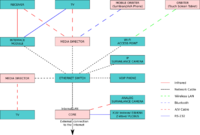Core
| Version | Status | Date Updated | Updated By |
|---|---|---|---|
| 710 | Relevant info | 2nd June 2011 | purps |
| 810 | Relevant info | 2nd June 2011 | purps |
| 1004 | Unknown | N/A | N/A |
| 1204 | Unknown | N/A | N/A |
| 1404 | Unknown | N/A | N/A |
| Usage Information | |||
The LinuxMCE Core server
A Core is a single dedicated PC acting as a server that interacts with all the components of the system. This is the most important component of a LinuxMCE system since it runs all of the primary applications and services. It is the heart and brain of the LinuxMCE system, the main server in your LinuxMCE home automation/multimedia network.
The core serves as:
- a multiprotocol router
- a communications hub for all connected devices: it routes home automation messages and commands.
- the networking router of the multimedia network
- a PBX for all connected IP telephony devices and media directors
- a central repository
- the storage location for the configuration of all the devices
- a PXE server distributing boot images to media players
- a storage device for media
The Core is the central point of the LinuxMCE system. It runs applications and daemons needed for the other devices to exchange messages. It is generally left on all the time. When it is turned off, LinuxMCE functionality everywhere else in the home stops working since it provides processing services throughout the home.
Centralized configuration and administration
Configurations
All the settings are stored in the Core Server, including network settings and device configurations.
Each component's location, functions, and options are stored on the Core. This enables plug-and-play operation throughout the LinuxMCE system for all AV devices connected anywhere within the system, even those connected to another (such as a Media Director PC) in another part of the house. For example, the AV devices are connected to the Media Director(s), nevertheless, they are managed by the Core.
The Core individually keeps track of the controls and settings of every device on the system. In the LinuxMCE Admin panel, A/V devices settings are specified separately from the settings of the Media Directors to which they are connected. This is done because the Core individually keeps track of the controls and settings of every device on the system.
Administration
The Core Server provides a standardized LinuxMCE Admin Website accessible via web browser from any Media Director. Since all devices part of the LinuxMCE network are listed and configured on the Core, the entire system can be administered from any Media Director, and you can run the Core Server without a monitor, keyboard, mouse or any other input or output device if you choose to do so. It is a true server. In this configuration, the server is said to be running "headless".
Plug 'n' Play Capabilities
Once LinuxMCE is installed, you can treat it like an appliance -- plug it in, turn it on, and leave it alone. You don't even need to install any software on the media PCs that will be used as Media Directors. If these PCs are connected to the Core by wired Ethernet, they can usually be set to boot LinuxMCE from the Core server over the network whenever you want to use them as a Media Directors. The rest of the time they can be used as a regular PCs, using whatever operating system is already on their hard drives.
For this to work, it is recommended to have two Network Interface Cards in the Core -- one to connect to the "external" network (which can be your home LAN or simply your Internet connection), and one for the "internal" LinuxMCE network (to which all your LinuxMCE devices are connected). All devices on the LinuxMCE LAN are considered "internal", and any device on your home LAN is considered "external". The Core serves as a bridge between the LinuxMCE LAN and the internet when internet access is requested by LinuxMCE (internal) devices. The LinuxMCE Core server effectively acts as both the DHCP server and the firewall for the "internal" LinuxMCE network.
To recognize each device and send it the necessary software, it is necessary that the LinuxMCE Core read and answer DHCP requests. It needs to be the only DHCP server within your LinuxMCE internal network, in order to offer both plug-and-play and network boot services. You can keep a DHCP server on your home (external) LAN as long as its relationship with the Core is the Core's "external" Network Interface Card, but the Core should be the only device to serve DHCP within the internal network.
Note that you can easily have PCs outside of the LinuxMCE internal network, if you choose. Simply connect them to the external network, rather than the internal LinuxMCE network.
Alternatively, you can choose to have all PCs in your house be part of the LinuxMCE network. In this case the Core server provides DHCP and firewall services for your entire home LAN, and all you computers can be used as remote controls.
Netboot services
With all the settings for Media Directors and all other devices centrally stored, it is possible to netboot devices from the Core. The Core PC provides standardized netboot services on the network. It listens for and auto configures all sorts of devices, including network audio players (e.g. Squeeze Box), IP phones and cameras, and Media Director PCs.
The Core server detects each device and makes it accessible to all the other components. With this plug-and-play back-end, the Core can automatically provide a network boot to thin-client PCs, and issue them the OS necessary to turn them into Media Directors.
System administration and updates are easy since only the software stored on the Core needs to be upgraded.
Core PC hardware selection guide
To learn about the PC components necessary in a Core, read the Core - Hardware selection primer
